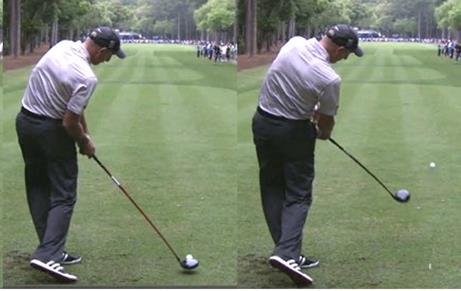Individual Joint Positions Matter
- Excessive whole-body movement and individual joint positions BOTH matter.
- Which joints are important for a successful golf swing.
- Only the MGSS full-swing does all that is required.
The last (December 8th) blog post discussed how the brain’s control of all movement is complex, and changes constantly, especially under conditions of anxiety, fatigue and injury. Thus it makes sense to reduce the amount of movement that golfer makes, which would then require less brain-commands, to fewer muscles, and serve to simplify the brain’s job! It was also discussed that the movements to be retained should be those that are “free” and do not come at a high cost.
The only truly “free” downswing movement is the rotary “coil-uncoil” one, as explained in the previous post. Further evidence for this “free” force availability comes from a seminal work by the king of seminal works on the spine – Professor Stuart McGill, of the University of Waterloo, Canada – in which he studied the potential of the muscles to create both linear and rotary force when already pre-rotated (as the Minimalist Golf Swing i.e. MGS is!).
Some direct quotes from his 1990 study “Kinetic Potential of the Lumbar Trunk Musculature…”:
“Most muscles (his study mainly assessed muscles at the L4-L5 lumbar joint) increase their potential to contribute to axial torque with greater amounts of twist.” Even the rectus-abdominus and the erector spinae group, which are basically vertical muscles that mainly bend the spine forwards and backwards, are able to contribute to trunk rotation when they are pre-rotated.
Another meaningful quote, “Changes in muscle length are an important consideration, given the modulating effect of [the muscle’s] length on force production: …a lengthened muscle produces additional force from passive stretching of the passive elastic component of muscle.”
And finally, “Various extreme postures appear to affect the moment potential (line of muscle action or moment arm) of individual muscles and the collective sum of agonists [main muscles acting to create a movement] contributing…”
Thus it may be said that rotary backswing action can produce significant pull on the joints to help create greater downswing clubbed speed, more so in the case of the MGS with its trunk being rotated pre-swing.
However, mere rotation is not enough, it must be sequenced from the ground up, and this can only happen if certain important joints of the golf swing are positioned so as to aid, and not hinder, pure trunk rotation.
Firstly, the hips should be level at the start of the downswing. if the trail hip is higher than the lead one, and flexed too (as is the case with all typical swings) the butt muscles of that side have to work to level the hips before pure rotation can begin. That involves two movements, whereas pure rotation is only one, which makes more sense given the time constraint of the downswing. The downswing lasts at most 1/3rd second, within which all the unbending and untwisting of joints bent or twisted during the backswing has to be completed.
Secondly, and even more importantly (because this second position will probably improve the first one too), the trail trunk must remain laterally flexed (side-bent) throughout the backswing. The line of action or the direction in which three important muscles can pull the body changes dramatically (to either help or hinder the downswing), based on their positions at the top. Trail side lateral flexion (especially when combined with pre-swing rotation of the trunk) is perhaps the most important movement of the back- and downswings.
In a typical swing, the trail side is always higher at the top of the backswing. As a result the main muscles of torso and arm rotation – the external obliques, pectoralis major and latissimus dorsi – get pulled upwards during the backswing, so that their line of action is only good for pulling the trail trunk and shoulder down and forward during the downswing. Hence the over-the-top (OTT) movement (defined here as the lead arm and clubbed move drastically inside the target line post-impact) that most golfers have. Even the professionals have this movement, if you go by this particular definition of OTT! The forward and down movement of the trunk which takes place at great speed, both at and post impact – if not before – is what causes most injuries of the spine and other major joints too.



It can thus be seen that for the body to avail of the free force available to it (that of stretched core muscles) and to simplify the brain’s role of controlling movement, it is important to reduce/remove up-and-down, down-and-up-again, and side-to-side movements; maintain the rotary one; and position vital joints of the body appropriately.
The MGS provides a golfer with more of the “free” force and less of the “dangerous” ones, and positions the joints for more effective downswing movement. Overall, it positions the golfer at the “top of the downswing” so that all joints are situated correctly for their roles in the downswing. No time is wasted in “transition” from top of backswing to top of downswing, which truly is a case of undoing the unnecessary. Even though changing to MGS requires a swing change of existing golfers, it does not have as steep a learning curve, because the unusual new set-up triggers the new backswing so that a golfer is not confused between old and new movements. It also uses positions which prevent bad sequencing while facilitating good movements, so that the famed summation-of-speed aka kinematic sequence aka proximal-to-distal sequencing of lower body before upper body happens effortlessly and unconsci


